by Editor | Jun 20, 2011 | Luxury Travel
Article and photos by Laura Scheiber
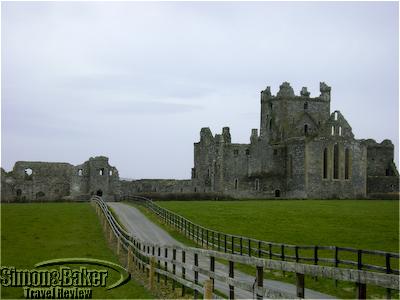
Driving along in the countryside in County Wexford
This was my third visit to Ireland, but the first time touring the South East of the Green Isle. After landing in Dublin on a sunny spring day, my travel partners and I spent the next six days exploring the many delights of County Wicklow, County Wexford, County Waterford, and County Kilkenny. Driving gave us the opportunity to take in the idyllic green countryside, impressive coastline, and fascinating medieval architecture.
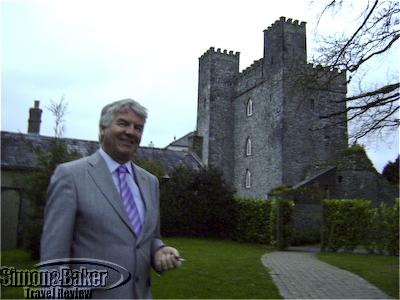
Ken Healy, proprietor, Barberstown Castle
Throughout the week we stayed in five different luxury accommodations: the Shelbourne Hotel Dublin, a landmark building in central Dublin (27 Saint Stephen’s Green, Dublin 2 Ireland, + 353 1 663 4500, www.theshelbourne.ie), The Ritz-Carlton Powerscourt, a well known countryside spa and resort (Powerscourt Estate, Enniskerry, Ireland, + 353 1 274 8888, http://www.ritzcarlton.com/en/Properties/Powerscourt/Default.htm, powerscourtreservations@ritzcarlton.com), Dunbrody Country House Hotel, a country Georgian manor situated in 300 acres of lush gardens (Arthurstown, County Wexford Ireland, +353 51 389 600, http://www.dunbrodyhouse.com/, info@dunbrodyhouse.com), the Cliff House Hotel, a seaside hotel (Ardmore, County Waterford, Ireland, + 353 24 87 800, http://www.thecliffhousehotel.com/, info@thecliffhousehotel.com), and Barberstown Castle which dated back to 1288 (Straffan, County Kildare, Ireland, +353 1 6288157, http://www.barberstowncastle.ie/).
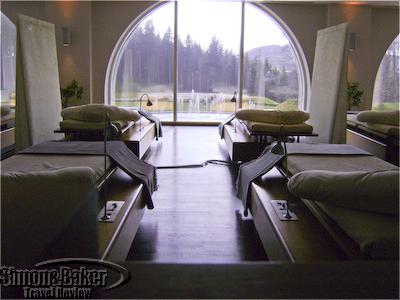
The Serenity Room at Espa at The Ritz-Carlton Powerscourt
I thoroughly enjoyed all of the accommodations and hope to return. One of the most memorable facilities was the spa at The Ritz-Carlton Powerscourt. Boasting 33,000 square feet in size, I especially enjoyed the pool that had 160 Swarovski crystals embedded in the bottom. The crystals reflected onto the ceiling to give the effect of a starlit evening. Situated in a low-lit room, I felt as if I was swimming in my own private pond on a summer’s evening. Simply divine.
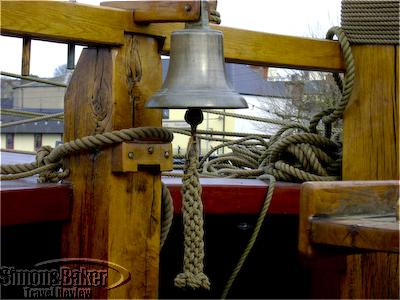
Original bell from the Dunbrody Ship
On our third day, we visited the Dunbrody Famine Ship in New Ross, County Wexford (+353 51 425239, http://www.dunbrody.com/). The ship was a replica of the actual one that transported thousands of immigrants to North America in the 1800s during the Great Famine of Ireland. Our guide offered a fascinating travel back in time, and the interactive nature of the ship museum brought to life the daunting journey families embarked upon in their quest for a better life. Being one of the more than 35 million Americans who can trace their ancestry to Irish roots, I found the Dunbrody Famine Ship so captivating that it instigated a desire to learn more about my family’s Irish origins.
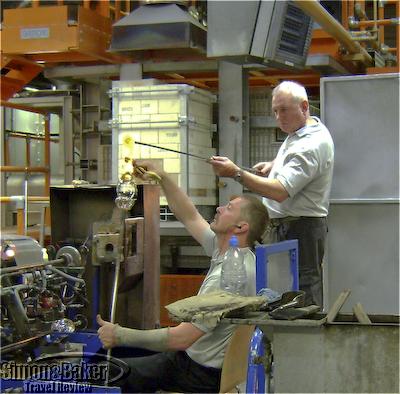
The Blowing Department at the Waterford Crystal Factory
The following day, we visited the new House of Waterford Crystal Factory (The Mall, Waterford City, Ireland, + 353 51 317000, http://www.waterfordvisitorcentre.com/). The 45 minute tour took us through the main working areas of the factory. I liked that the tour put us just feet away from the workers and we had the opportunity to interact with them. On that particular day, some of the sculptors were working on the People’s Choice Awards. While I am not a huge fan of crystal, I found the tour interesting and couldn’t resist purchasing a Waterford item available only in the showroom.
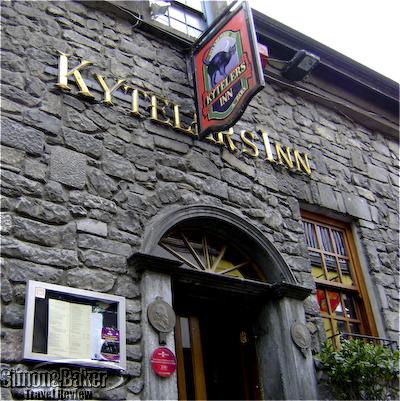
Outside of Kyteler’s Inn
My favorite cultural activity was a lesson on the traditional Irish bodhran drum at Kyteler’s Inn in Kilkenny (Kieran Street, Kilkenny, +353 56 772 1064, http://www.kytelersinn.ie/contact.asp). Our boisterous instructor, Helen McLoughlin (helenbodhran@hotmail.com), first demonstrated how to play the instrument and then sat us in a line of chairs with bodhrans in hand. She had us in stitches from her quick Irish wit, which helped ease our insecurities as we learned to play some basic rhythms. The interactive nature of the lesson which included singing traditional Irish folk songs lifted my spirits.
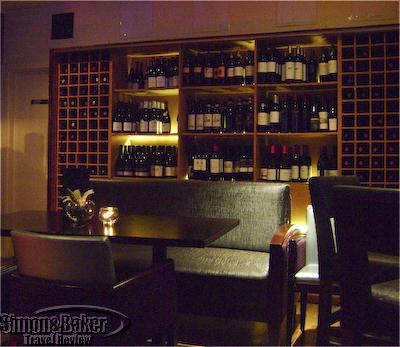
Downstairs bar at L’Escrivain
I was pleasantly surprised to enjoy five nights of outstanding gastronomy. In all of the restaurants, the executive chefs used fresh local produce and locally sourced seafood. My travel partners and I compared our favorite dishes. A professional foodie said that her main dish (Breckland duck with butternut squash and pine nut dressing) at L’Escrivain Restaurant (109a Lower Baggot Street, Dublin 2, + 353 1 6611919, http://www.lecrivain.com/, enquiries@lecrivain.com) was the best duck she had ever eaten.
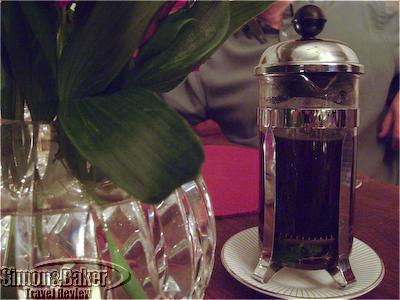
Beef tea at the Cliff House Hotel Restaurant
My favorite restaurant in terms of artistic food presentation and exquisite hospitality was The House restaurant at the Cliff House Hotel. We enjoyed a number of innovations by Executive Chef Martin Kajuiter such as “beef tea,” a beef broth for the Black Angus beef, which was delivered in a tea press teapot. I enjoyed the Helvick cod with spinach and Dingle Bay Crab carefully wrapped in a special package to seal in the flavors.
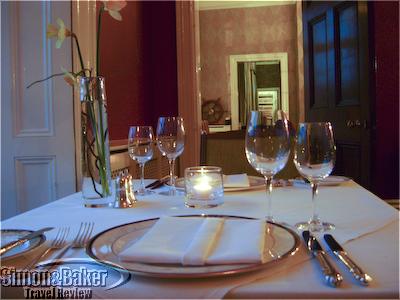
Dining table at The Harvest Room Restaurant
At Barberstown Castle, my six-course meal included scrumptious panned fried scallops and halibut in a citrus butter sauce. We dined in the oldest section of the medieval castle, and it felt as if I had been magically transferred back to the 1300s. The Harvest Room Restaurant at Dunbrody Country House Hotel offered a charming romantic country setting, and I will never forget that heavenly chocolate lava cake and divine Chateau Bel Air Perpencher, a Bordeaux red wine. The service in the restaurants was friendly and attentive without being overbearing.
All in all, my travels in South East Ireland were unforgettable. I would recommend the region to any of my family and friends who are captivated by Celtic history and culture, interested in finding out more about their Irish ancestry, or for those who enjoy the delights of gourmet Irish cuisine.
by Editor | May 31, 2011 | Accomodations, Attractions, Luxury Travel, Restaurants, Video
Article and photos by Elena del Valle

A temple in Tokyo
Earlier this year, before the earthquake hit, I spent a few days in Japan. Although my calendar was overfull it had been years since my last visit to Japan and I couldn’t resist a last minute invitation to the Land of the Rising Sun. Finding a desirable seat on the flights nearly caused the trip to fall apart before it even started. In the end I persevered and with the help of a friendly airline agent everything worked out.
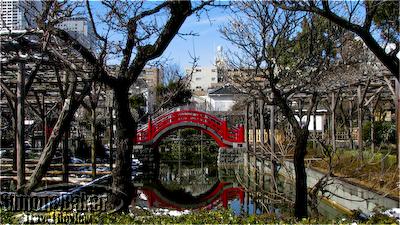
A beautiful garden and bridge in Tokyo
On my arrival at Narita International Airport, I cleared the airport formalities with ease and was thrilled the transfer service driver was waiting for me. He spoke English very well, allowing us to chat during the drive to the Hotel Okura Tokyo (2-10-4 Toranomon, Minato-ku, Tokyo 105-0001, + 81 03 3582-0111, http://www.hotelokura.co.jp/tokyo/en/), where I spent the first three nights in the city. The eleven story contemporary hotel located across the street from the United States Embassy, had 801 rooms, modern facilities, nine restaurants, a fitness center with a swimming pool ($70 per day for hotel guests), spa, ATMs friendly to foreign credit cards, WiFi router for rent (a router compatible with my iPad cost 4,725 yen or about $18 a day at the time) and service oriented English speaking staff. My room was contemporary in style and new looking with a glass enclosed shower, a separate bathtub and a Japanese toilet.
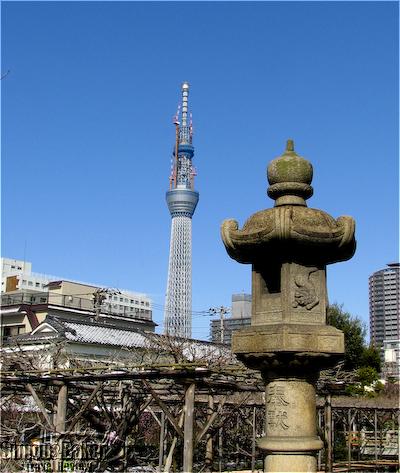
An old versus new contrast with a temple column in the foreground and the Sky Tree in the background
The first day I had breakfast at the Terrace Restaurant, a ground level restaurant facing a snow covered inner courtyard at the hotel. I liked the buffet’s Eastern and Western selection and a delicious tea made from fresh herbs. Later during my stay I sampled some of the items sold at the restaurant’s shop and was quite pleased with the quality.
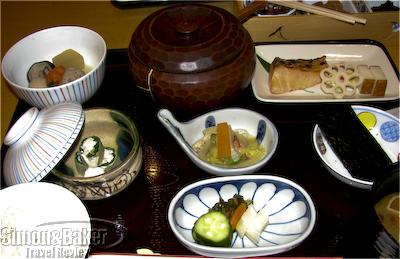
Breakfast at Yamazato restaurant at the Hotel Okura
By far my favorite breakfast in Tokyo was at Yamazato, the hotel’s Japanese restaurant. As I descended the stairs to the restaurant a young man at the entrance welcomed me in English and led me to a table. Even though the two times I was there I was the only Westerner I felt welcome. The wait staff spoke a few words of English making it possible for us to communicate basics. The servers brought me a glass of water when they spotted my vitamin pack. One of them offered to serve me beef or pork in case I didn’t want fish but what is a Japanese breakfast without fish?
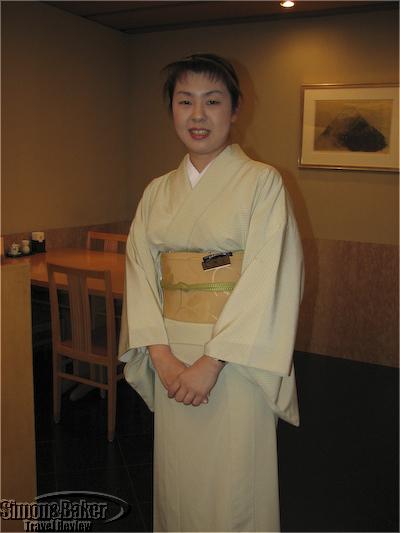
A waitress at Yamazato restaurant at the Hotel Okura
The Japanese breakfast came in a bento box with rice, fish dish (sauteed yellowtail, octopus), hearty and especially flavorful miso soup, pickled vegetables, steamed vegetables, bamboo shoots, mushroom, eggs, and a couple of unidentified dishes. Everything was delicious.
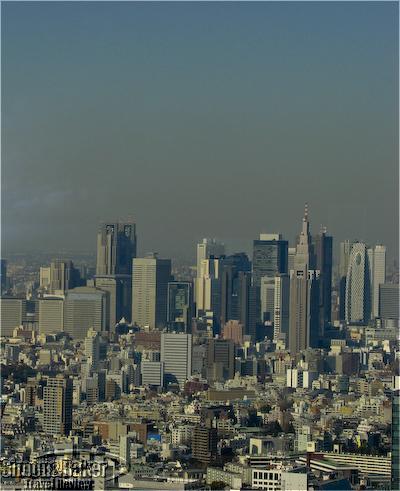
The Tokyo skyline from the Mori Building
In the same way that New York is associated with the Big Apple, Sumiyo, our tour guide, explained, visiting the city of Tokyo can be thought of as exploring an egg. Architecture Guide in Tokyo, a color brochure in English, explained the ways in which Tokyo is like an egg; a handy map on the back pointed to the salient architectural areas of the city. The 284-acre imperial palace appeared in the lower right side of the egg. The inside of the brochure contained a series of descriptions of architectural areas of note within the city based on the egg simile: Omelet-rice for semi-European before 1945, Bacon egg for Western styles before 1945, Atsuyaki tamago Japanese style before 1945, Egg sand for modern style between 1945 and 1975, Boiled egg for plain style between 1976 and 1985, Scrambled egg for post modern style between 1986 and 1995, and Pudding after 1996.

The National Art Center in Tokyo
During the next two days, we would be seeing several neighborhoods within the “egg” of Tokyo, a metropolis of 13 million souls established in 1868 following the collapse of the shogun government. We began across town from our hotel with a visit to Edo Kiriko in Hanashyo (http://www.hanashyo.com), a 60 year old family owned fine cut glass store and workshop. The traditional Japanese home where it was located had such narrow spaces only four or five people could enter at one time. During our visit we watched the owner and his young apprentices engrave and hand polish each colorful piece without using hydrochloric acid at a ground floor workroom, and we saw the finished cut glass pieces on display in a small upper floor showroom. Hanashyo sold Kome-tsunagi, Itokiku-tsunagi and Tama-ichimatsu, three registered proprietary designs. We also visited a second showroom where glass cutting classed were offered. We were invited to experience cutting glass for ourselves for a couple of minutes each. It was fun.
One of my favorite experiences in Japan was a special abbreviated daytime performance of four geishas at Hisago-an restaurant (in Japanese only, http://kaiseki-hisagoan.com/course_hisagoan.html/). The geishas we saw that day normally only perform at the restaurant at night. Three of them danced, one sang briefly and the most senior one played a banjo like instrument. Following the dance they demonstrated one of the games they play while entertaining guests and, with the help of an interpreter, answered questions. In their company we took a rickshaw ride from the restaurant to Senso-ji (http://www.senso-ji.jp/about/index_e.html ), a nearby Buddhist temple, and strolled around the Asakusa area and its well known outdoor shopping arcade next to the temple. It seemed everyone was staring at us until someone explained it was the geishas rare daytime stroll that drew public attention.
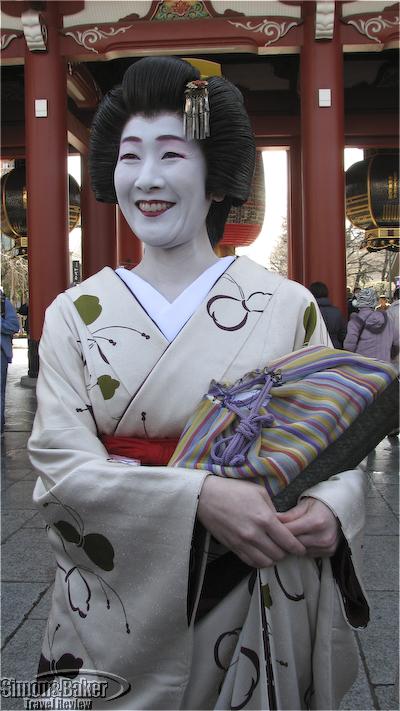
One of the geishas who walked with us
From there we drove to Omotesando Ukai-tei (http://www.ukai.co.jp/english/omotesando/index.html), a French influenced restaurant in a shopping mall where we had a Tenderloin Lunch Course, a refined and delicious four-course lunch. During the meal we noticed fine Ercuis French silverware and wood chopsticks, Reidel glassware, and embroidered napkins. We were served Dermotte non vintage Champagne followed by Assorted Appetizers, Roasted Bamboo Shoots, Shellfish Cream Soup, Ukai Beef Tenderloin Pan Fried and Dessert. Although we didn’t have a view from our seats the bar area had pretty city views. The restaurant, part of a chain of restaurants and museums, housed an exhibition space with a perfume bottle collection and a dessert lounge with Art Nouveau ceilings and lacquered pillars.
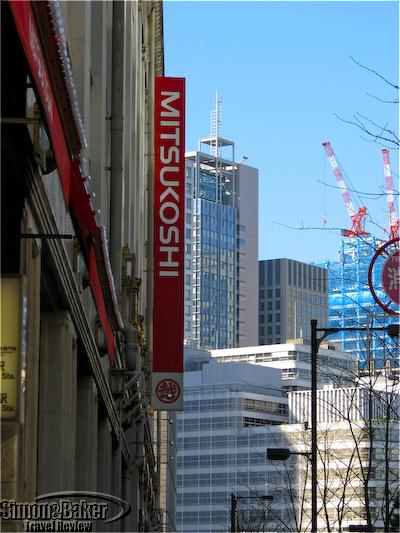
The main location of Mitsukoshi Nihonbahi, one of Tokyo’s most exclusive department stores
Following lunch we walked around the Omotesando and Aoyama areas. We visited the Espace Louis Vuitton Tokyo (Louis Vuitton Omotesando Building 7F 5-7-5 Jingumae, Shibuya-ku, Tokyo 150-0001, +81 03 5766 1088, www.espacelouisvuittontokyo.com) which was hosting French artist Xavier Veilhan; and the Ukiyo-e Ota Memorial Museum of Art (http://ukiyoe-ota-muse.jp/index-E.html), housing a collection of Ukiyo-e Japanese woodblock art.
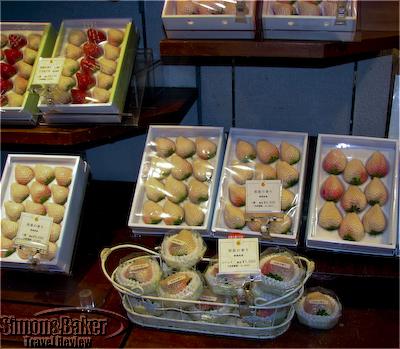
Strawberries for sale in the food hall of the Mitsukoshi Nihonbahi store
The next day after my delightful Japanese breakfast I was ready to face the cold again. This time we visited the main location of Mitsukoshi Nihonbahi store (Nihombashi Muro-machi 1-4-1, Chuo-ku, Tokyo 103-8001, +81 03 3241 3311, http://www.mitsukoshi.co.jp/store/fcs/english/1010/index.html), one of the most exclusive department stores in Tokyo. We arrived just in time to watch the opening ceremony at 10 a.m. during which the store staff welcomed arriving guests with deep bows. My favorite area of the beautiful and well stock multi-story store was the lower level where the food shops were located. It was filled with all types of hard to find eatable items including pastries, seafood, meat, chocolate, vegetable and fruit delicacies. I could have spent at least another hour exploring the food halls and tasting samples.
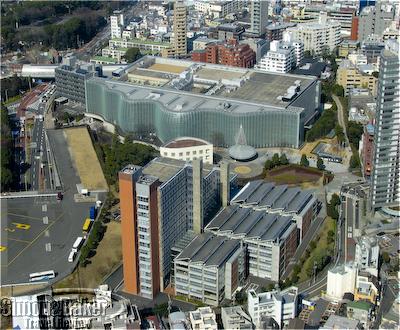
Another view of the city from the Mori Tower
From there we went to the Mori Tower in Roppongi Hills for an outstanding skyscraper view of Tokyo (http://www.roppongihills.com/tcv/en/ ). That morning we visited Tokyo Midtown, walked by the Mori Art Museum (http://mori.art.museum/eng/index.html) dedicated to promoting “art and life in the 21st century,” and the Suntory Museum of Art (http://www.suntory.com/culture-sports/sma/) dedicated to challenging conventional attitudes to the classification of art to reveal its beauty.
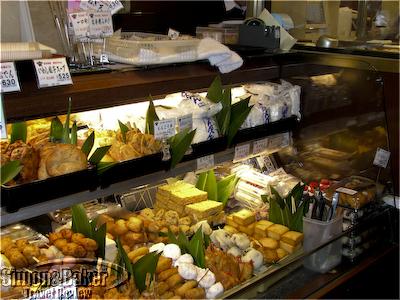
A display at the food hall of the Mitsukoshi Nihonbahi store
Lunch was at Rakutei (+81 3585 3743), a tiny family owned restaurant in Akasaka. Although there was no sign on the building to indicate the existence of a restaurant once inside we were welcomed in Japanese and invited to enter. We sat at a small counter facing an open cooking area. At first it looked like a sushi bar but we soon discovered it was not. An elderly man and his assistant were busy preparing the meal while the man’s wife placed dinnerware in front of us and offered us beverages. We had warm sake and a delicious tempura lunch served two bites at a time until we surrendered.
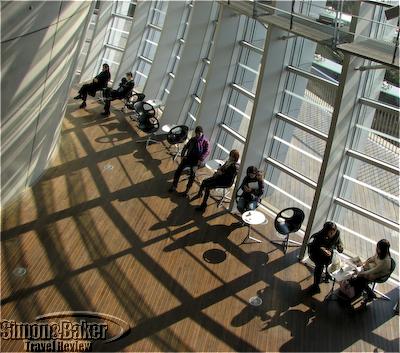
The interior of the National Art Center in Tokyo
After a lightning fast visit to the National Art Center (http://www.nact.jp/english/index.html ), a 14,000 square meter large venue for temporary art exhibitions, we ended the day with a stroll in a Ginza district shopping street. Ginza, meaning place where money is made in Japanese, is one of the most popular and most expensive tourist shopping areas of Tokyo, our tour guide explained.

A dragon water fountain in Shuzenji Village
After breakfast the next morning we drove to Shuzenji, a two and a half hour drive from Tokyo, for an overnight stay at Yagyu-no-sho, a traditional Japanese ryokan. By the time we had a tour of the traditional style ryokan, found our rooms and explored the area by the ryokan it was time for dinner and we retreated indoors.
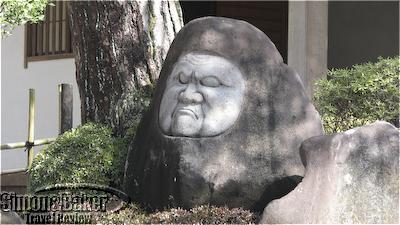
A stone head at the entrance to the Shuzenji Temple
The next day our visit to a local pottery artist’s shop was canceled providing an unexpected opportunity to stroll through Shuzenji Village, exploring the shops and visiting the interior of the Shuzenji Temple, a rare treat before our return home.
by Editor | May 2, 2011 | Luxury Travel
By Elena del Valle
Photos by Gary Cox
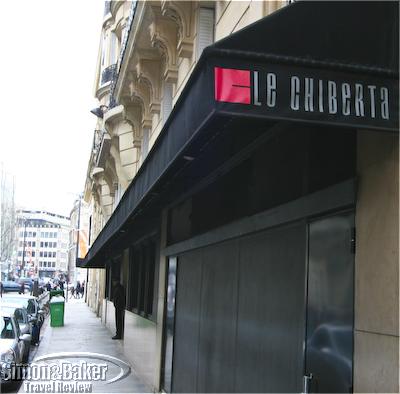
A street view of Le Chiberta
It was lunch time on a quiet winter day when we first discovered Le Chiberta. As we entered the restaurant through twin glass doors we encountered welcoming faces. A young lady took our coats and within minutes we were seated at a comfortable corner table near the entrance, next to a window.
Although the simple decor in black and charcoal gray revealed little about the food we might expect we had high hopes for the restaurant, owned by Guy Savoy, one of the city’s best known chefs. In the past, we had dined at Restaurant Guy Savoy, the chef’s eponymous restaurant, with quite positive results and were looking forward to trying out Le Chiberta, a budget friendly alternative.
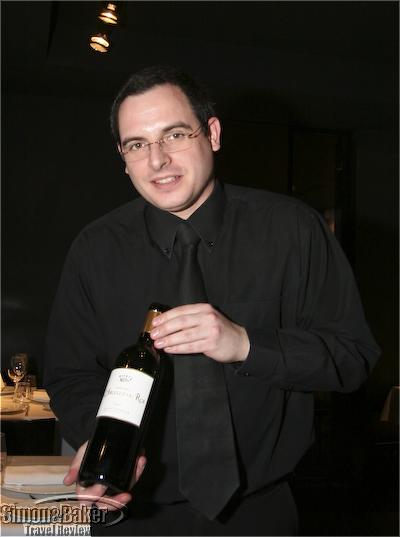
Our server Francois
We were the first guests to arrive at the restaurant with capacity for 80 situated in a quiet small street very near the famed Champs Elysees in Paris, France. Slowly others from near and far arrived. We shared our section of the dining room (there were several sections) with three tables of two and were looked after mainly by Francois, an English speaking server who was friendly and very helpful.
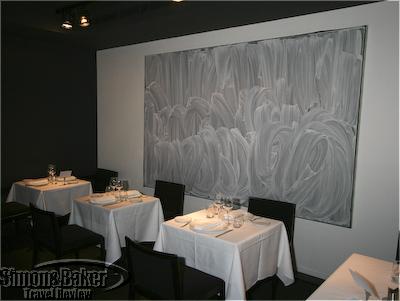
The artwork added texture to the decor
At our table the only decorations were the meal service and a simple steel colored salt and pepper set. While we awaited our lunch we observed the interior décor, which was somewhat similar to the familiar Guy Savoy sister restaurant. It was the work of Jean-Michel Wilmotte and was meant to emulate an informal club style. Across from our table there was an over large oil painting. We noticed bottle-lined walls in the adjoining dining room and hallway. These were understated and juxtaposed with contemporary works of art by Bertrand Lavier and Gérard Traquandi.

Champagne and amuse bouche bites
We began our lunch with a glass of Laurent Perrier Champagne. Soon two amuse bouche bites appeared and shortly after that a bread basket with two types of bread and Saint Malo seaweed butter arrived. We left our selections in the hands of the chef who delivered a well balanced and refined meal. He served: Amuse bouche Crème de carotte à la citronnelle-gingembre gambas rôtie aux épices douces; Terrine de foie gras de canard artichaut et figue royale de foie gras chutney de kumquat et mangue; Filet de daurade royale à la plancha écrasée de potimarron, salade amère jus au sarrasin; Suprême de colvert rôti, cuisse confite fricassée d’épinards, artichauts et trompettes de la mort jus salmis; Brie truffé et mascarpone salade de mâche; Tout clémentine; and Le cube chocolat-café. It was served with white: Beaune Longbois 2008 Domaine Berthelemot; Condrieu Chauson 2007; and Domaine du Monteillet, S Montez wines; and red wines: Château L’Argilus du Roi 2007 Saint-Estèphe and a dessert wine, Maury Mas Amiel vintage 2008.
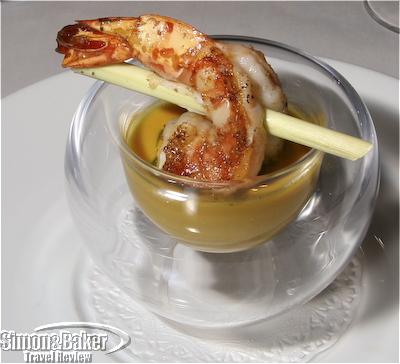
The prawn and ginger carrot soup
The first course, a favorite and we learned after we finished every bite, one of the restaurant’s specialties, featured a carrot ginger soup in a glass bowl with a single prawn skewered by a lemon grass stick. The next course was foie gras with artichoke and fig in the middle, accompanied by warm foie gras cream served in a small glass with kumquat and mango chutney. There was additional chutney with a tiny bite of sweet tuille to accompany the dish; warm toast were served with it. It was served with a citrusy light white wine.
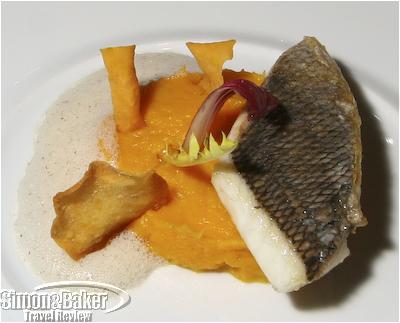
The dorade with mashed pumpkin
Dorade fish (a favorite) served with mashed pumpkin and a foam came next. It was accompanied by an oaky white wine. Wild duck from the forest served very rare with marvelous mushrooms and a little spinach came next. It was accompanied by a lovely 2007 Saint Estephe red. Truffled brie with home made truffle filling served with black truffle shavings and a salad of baby mache with a vinegar dressing was the perfect follow up to the wild duck. A tangerine palate cleanser followed the cheese and a wonderful chocolate cube and coffee ice cream dessert completed the meal. It was served with a velvety red dessert wine.
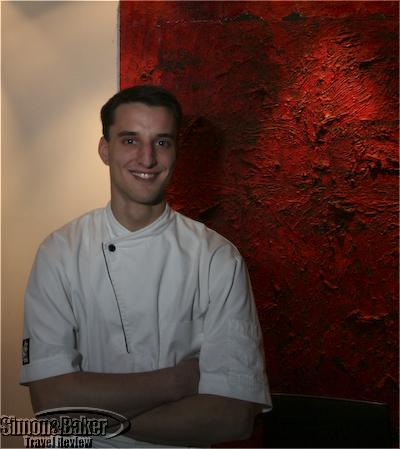
The chef at Le Chiberta the day we visited the restaurant
It can be challenging to find a satisfying meal without spending a fortune in that very touristy area of Paris. Le Chiberta, established in 2004, combined a desirable location with excellent food and attentive service in a pleasant setting. Kudos to Chef Guy Savoy and Stéphane Laruelle, Le Chiberta’s executive chef.
Le Chiberta (Le Chiberta, 3, rue Arsene Houssaye, 75008, Paris France, Telephone +33 1 53 53 42 00, Fax +33 1 45 62 85 08, www.lechiberta.com, chiberta@guysavoy.com) is now part of very our short list of options anytime we are in the mood for well a prepared yet unpretentious meal in area of the Champs Elysees.
by Editor | Apr 25, 2011 | Luxury Travel
By Gary Cox
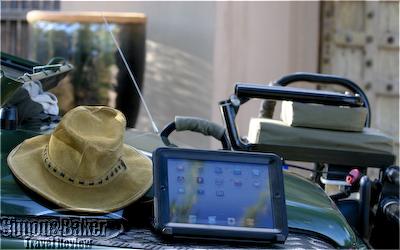
In the bush with our iPad on the hood of the Range Rover at Africa House
Our iPad has proven to be an excellent tool when traveling to process email, create documents and preview photographs. Among the wide variety of sleeves, covers and folios available for it, the OtterBox Defender stood out with its focus on protecting the fragile device in rugged environments. We were departing to spend several weeks in the game reserves of South Africa and wanted a case that was functional and could provide protection during the transfers over dirt roads and rough handling by porters.
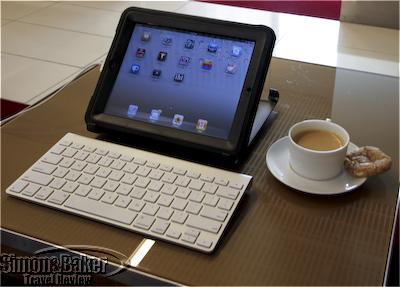
During a layover in the Air France lounge
Assembly was relatively easy, although we did not use the clear plastic screen cover, having already installed one made by a different manufacturer the day we bought the iPad. The installation video on the OtterBox website was helpful and better than the tiny illustrations on the package cover. The cleaning cloth is also a nice bonus and comes in handy when fingerprints are visible after a hard day of use. Disassembly with the third party screen cover can be challenging and we do not plan on putting the cover on and off frequently.

A cleaning cloth was included with the Defender
Once the Defender was assembled, the iPad feels heavier, but simultaneously easier to grip and more solid in general. All of the necessary buttons and ports are easily accessible either right through the cover or by opening a tiny flap in the case of the headset jack. With the case installed, it is more comfortable to set the device down on a table or other hard surface without concern for the iPad. There is a small panel that can be removed to allow access to the interface port for charging and connecting to external devices.
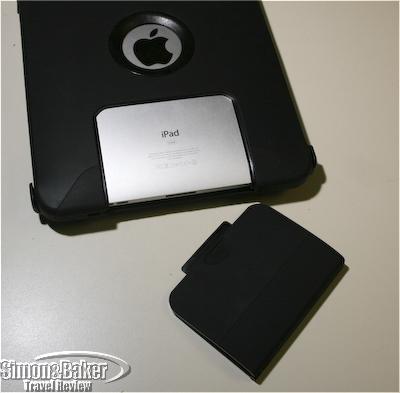
The case with the interface panel removed
A favorite feature is the hard shell cover which can be snapped on to protect the face of the device, or snapped on the back of the iPad and out of the way. It also doubles as a stand to support the iPad at a comfortable viewing angle. With the Bluetooth keyboard connected and the iPad resting on its stand, editing a document or navigating the web is as efficient as using a laptop computer. The stand is sturdy and secure enough to allow fingertip control, an essential function of the device.
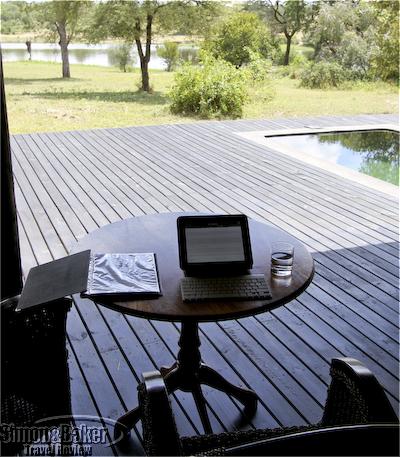
Working at Chitwa Chitwa lodge with the iPad on the stand
Turning the iPad off and attaching the shell over the face allowed us to pack the device into our camera box without worrying about it being damaged, scratched or accidentally turned on and running down the batteries. We picked up a sleeve for the keyboard from WaterField designs in San Francisco. This combination was low profile and kept our equipment in top shape throughout our lengthy journey.
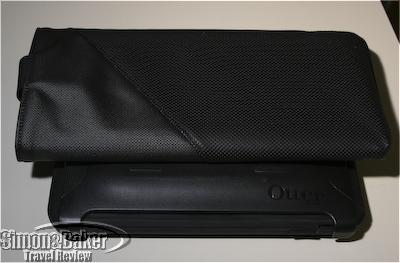
The iPad with the cover installed and keyboard in its sleeve
The case kept our first generation iPad safe and secure throughout our safari travels and for daily use at home as well. With the improved grip and rubberized exterior the iPad is friendly to glass tabletops and when passed from one person to another. The exterior is attractive and consistent with the iPad design. We plan to leave the iPad in the OtterBox Defender case (Otter Products LLC, 1 Old Town Sq #303, Fort Collins, CO 80524 888-695-8820, +1 970-493-8446, http://www.otterbox.com/, customer.service@otterbox.com) for the foreseeable future.
by Editor | Apr 18, 2011 | Luxury Travel, Products
Article and photos by Joachim Castellano
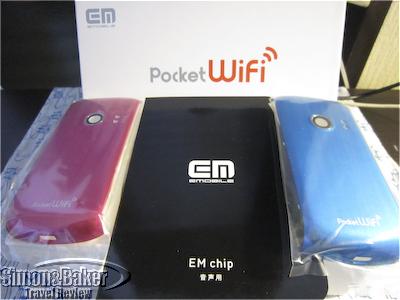
The Emobile Pocket WiFi-S package and covers
The Emobile Pocket WiFi-S (model number S31-HW) is a versatile Android-enabled smartphone that stands out thanks to a superb feature: with a touch of a button the user can create a personal Wi-Fi hotspot. In Japan, the only place where it was available when I tested it for 42 days, locating public Wi-Fi can be very difficult. Having my own Wi-Fi means I never have to worry about finding a wireless network that connects with my laptop, iPad, or gaming device. I can connect up to five different gadgets simultaneously.
In practice the wireless performance of this 105 gram phone manufactured by Huawei Technologies of China and distributed by Emobile of Japan wasn’t as fast as the Emobile’s Wi-Fi only Pocket WiFi (D25-HW) model. At times, the plastic and glass Pocket WiFi-S’ speed noticeably struggled in the slow lane; that was likely when Emobile’s network traffic was particularly clogged.
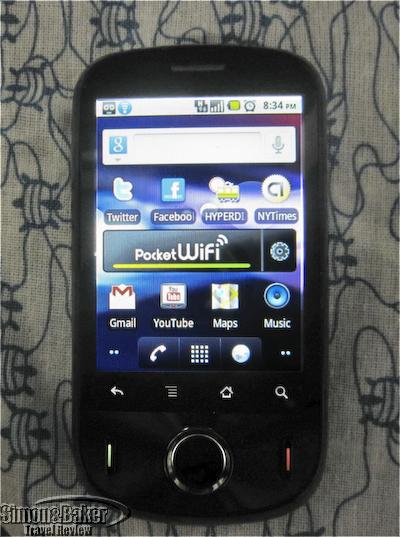
The front of the Emobile Pocket WiFi-S
What I lost in speed, however, I gained with the versatility of a full-fledged smartphone. I was able to make phone calls, browse the web, send and receive email, consume media, and navigate with GPS just like with any standard smartphone on the market. Also, because it runs Google’s Android mobile operating system, I was able to download apps from the Android App Market. For example, train schedule and route apps like Hyperdia or Jorudan helped me navigate the labyrinth of Japanese rail. I downloaded one of these apps and recycled the wrinkling pocket rail guide I had been toting around.
The smartphone, 54.8 × 104 × 13.5 millimeters in size, ran Google’s Android 2.2 operating system with a menu system in English and Japanese. The wireless (b/g) WiFi hotspot was capable of connecting up to five devices at HSPA 7.2Mbps down/5.8Mbps up connection speeds. It included a rear-facing 3.2 megapixel photo and video camera, 2.9 inch touchscreen, built-in speaker, 3.5 mm audio jack, Bluetooth 2.1, and had 512MB of memory with expandable memory through a microSD slot.
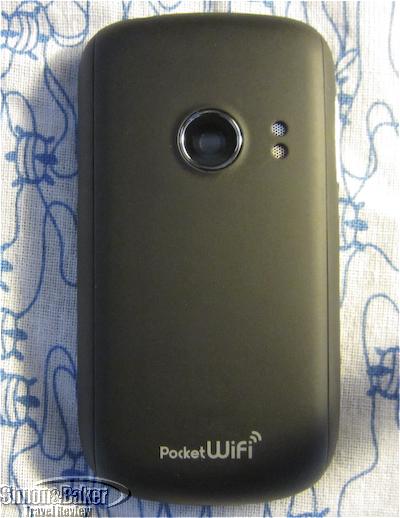
The back of the Emobile Pocket WiFi-S
The phone I tested had a battery length of five hours of talk time, four hours of standard usage, and 240 hours of standby. It came with one battery pack, AC adaptor, USB cable, microSD card, and three color covers, black, blue, and pink. The retail price was 19,800 Japanese yen ($235) as part of a two year contract, and phone and data plan costing about 8,000 Japanese yen ($95) per month.
While not as slick and graceful as its fruity and shiny rival, the Pocket WiFi-S does have that personal Wi-Fi network trick up its sleeve.
by Editor | Apr 11, 2011 | Luxury Travel
By Elena del Valle
Photos by Gary Cox*

The entrance to the Hotel Plaza Athénée
After our last visit to the Alain Ducasse restaurant at the Plaza Athénée in 2008, the famous French chef announced he was going back to basics and installed a new chef at his best known restaurant in Paris, France. While this could spell disaster or significant changes in the dining experience elsewhere on our most recent visit to the Plaza Athénée gourmet venue late last year we discovered it did nothing to mar the superlative dining experience offered at the Restaurant Alain Ducasse au Plaza Athénée.
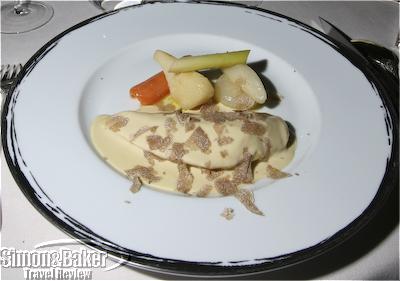
Alba chicken with fresh white truffle
We were pleased to find favorites like the Alba truffled chicken dish and new selections like the crock pot cooked lobster. The ambiance and service were outstanding in spite of a full dining room.

Many of the dishes included a final flourish delivered at the table
When we heard they had redecorated the restaurant we expected radical changes. Instead the designers kept the classic and modern combination decor and added an artistic touch. Four large screens were covered in unique pieces of embroidery representing produce, garlic, mushroom, and artichoke.
It required a team one year to bring the embroidered screens to life from the graphic designs created by Patrick Jouin. Stefan Glass provided the expertise of the Müller workshop near Nuremberg, Germany where the pieces of satin and leather were cut with high precision machinery.
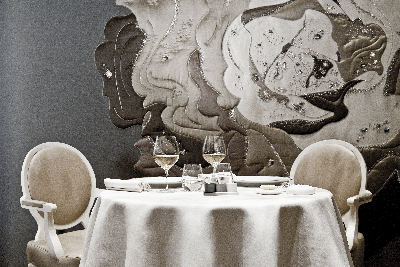
A table and one of the new embroidered screens at Restaurant Alain Ducasse au Plaza Athénée
Once that was done Sébastien Barilleau from the Cécile Henri workshop in Paris, added beads, sequins, and tubes rock pearls with the traditional Lunéville technique (the embroiderers work on the back of the piece, positioning the haberdashery by touch on the front and stitching them in place with chain stitch). The screens returned to Germany for meticulous assembly of the sections and back to Paris for completion.
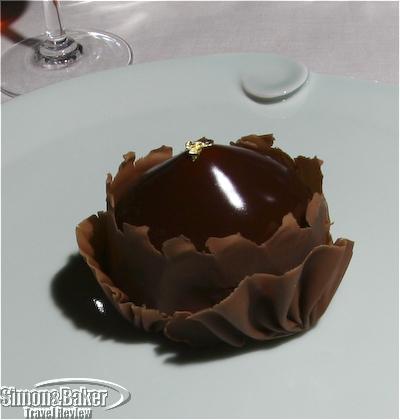
Chocolate dessert
Upholsterer Stéphane Corler positioned the silver, gold and bronze satin and leather panels with metallic blue-tinged stone and crystal embroidery on the screens. Visit the Simon & Baker Travel Review for information about Paris, fine dining and more about our December 2010 dinner at Restaurant Alain Ducasse au Plaza Athénée.
*Non watermarked photos copyright Pierre Monetta courtesy of Restaurant Alain Ducasse au Plaza Athénée




















































